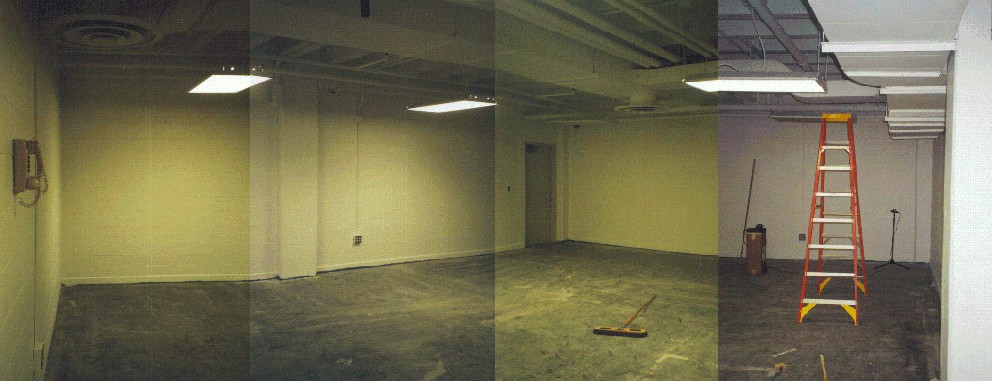Measured Room Response
The room is 9.25 m long, 7.65 m wide, and 3.15 m high. The walls are painted cement blocks, and the floor was unpainted concrete (later covered with carpet). The ceiling is not flat, but has a number of cement "cross beams" which may increase the reverberation time by providing lots of reflective surfaces for sound to bounce around. Using a Tascam DA-P1 portable DAT recorder and an Audio Technica AT4041 microphone I made recordings of the room response to a hand clap and to human speech.
Estimated Reverberation Time
The Sabine equation for estimating the reverberation time, T60 is
 where V is the volume of the room, c=343 m/s is the speed of sound in air, S is the total surface area of the room.
where V is the volume of the room, c=343 m/s is the speed of sound in air, S is the total surface area of the room.  is the average absorption coefficient for the room, calculated from is the average absorption coefficient for the room, calculated from
 where
where  1 are the individual absorption coefficients for each surface S1 and S is the total surface area of the whole room.
The absorption coefficients for cement block walls and floor are: 1 are the individual absorption coefficients for each surface S1 and S is the total surface area of the whole room.
The absorption coefficients for cement block walls and floor are:
| Frequency (Hz) | 125 | 250 | 500 | 1000 | 2000 | 4000 |
| Concrete block, painted | 0.10 | 0.05 | 0.06 | 0.07 | 0.09 | 0.08 |
| Concrete floor | 0.01 | 0.01 | 0.015 | 0.02 | 0.02 | 0.02 |
| Carpet on concrete | 0.02 | 0.06 | 0.04 | 0.37 | 0.60 | 0.65 |
| Carpet on foam rubber | 0.08 | 0.24 | 0.57 | 0.69 | 0.71 | 0.73 |
Using these tables and equations, I calculate the reverberation time for the 1000 Hz band to be approximately 2.6 seconds for the empty room and about 0.93 seconds for the room with carpet.
|
Composite photographs of the empty room


Composite photographs of the room with carpet

|



 is the average absorption coefficient for the room, calculated from
is the average absorption coefficient for the room, calculated from

 1 are the individual absorption coefficients for each surface S1 and S is the total surface area of the whole room.
The absorption coefficients for cement block walls and floor are:
1 are the individual absorption coefficients for each surface S1 and S is the total surface area of the whole room.
The absorption coefficients for cement block walls and floor are:





